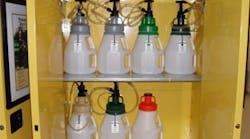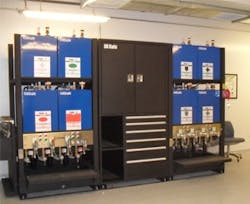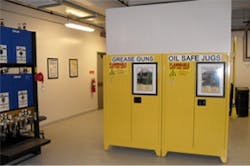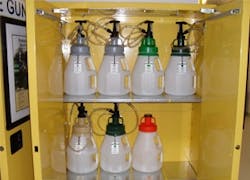This is the second of a bi-monthly series about one plant’s continuing journey to implement a world-class lubrication process.
Beer Guy here again with an update on how the implementation of our new lubrication management process is going. It’s been eight weeks since I rolled out our new bulk system, and I can confidently say the finish line is in sight. For those of you who missed Part I of this series or for those who need a refresher, I’m the lubrication technician for a beer manufacturing facility in the midst of implementing a world-class lubrication process. I’m documenting the entire process to share my experiences and findings as we strive to become the benchmark for other manufacturing facilities.
Updates
Figure 1. Building the new lube room to reflect and support all the colored tags and containers created a clean and organized the lube room with the bulk system holding tanks at the heart of it.
We’ve made incredible progress over the past two months, though we still have much of the journey to go. Building our new lube room to reflect and support all the colored tags and containers has kept us very busy. I am proud of the outcome so far, especially how clean and organized the lube room looks (Figure 1).
When I first scoped the project, I thought, once the OilSafe bulk system holding tanks were in position, I’d just need to implement the support items and everything would magically fall into place. Well, I underestimated how much the bulk oil handling system would transform the overall look of the room. The new bulk system was so nice, it didn’t make sense not to update the entire lube room to match the quality of the system.
So, it was on to updating the room. Initially, I thought I could get the entire lube room up to the level of the bulk system in a few days. However, after only setting and leveling the tanks and secondary storage lockers, as well as looking at all the support that was necessary, I had two days in already (Figure 2). Unfortunately, my free time is limited for extra projects like this since I am responsible for more than just lubrication in my facility and still have to keep up with my vibration rounds/analysis, oil analysis, and ultrasound support. However, I persevered in updating the lube room and have made great progress.
Figure 2. Storage cabinets keep our lube management equipment clean, organized and easily accessible.
I’m nearing the finish line on updating the lube room, or my “baby,” as I now refer to it. All of the lube room equipment is now labeled. One of my final tasks is to hang a broom rack; after all the work I completed, the last thing I want is any excuse to leave the lube room messy. Now I face the decision of who should be responsible to maintain this room, as I don’t have the time to make sure it stays clean and well stocked, nor do I actually own the room.
As a solution, I decided to create some preventive maintenance (PM) in our maintenance management system. The system delivers a PM to each of the two primary shareholder departments to ensure the lube room is properly maintained. Since there are two departments, the PM alternates every other month between them so they can share the duties of maintaining the space. I also wrote a personal PM for me to audit the area every 13 weeks to ensure things don’t get out of hand and the room stays as perfect as it is now. My hope is that this ownership and oversight will create awareness toward the end goal — sustainable and clean environment for our lubricants.
Preliminary results
As we all know, change can be difficult to accept and challenging to effect. But the many benefits we’re already seeing from the lubrication management system are proof that this change, and the simplification it provides, is absolutely worth it.
Figure 3. Transfer containers and labels make storage and transferring of lubricants simple and intuitive.
So far, we’ve seen fewer facility breakdowns since we implemented the new lube management system. The containers and labels make everything clear, so operators are recognizing potential issues faster and at a higher rate. Operators are now looking at their equipment, identifying issues and submitting work orders just because the oil doesn’t look like it should. Over the past three-and-a-half years, I’ve seen two or three work orders. We’ve had as many as 15 work orders submitted in the past few months since implementing the lube management system.
The lube management system is showing the greatest benefit with its custom colors, shapes and labels. Before, it was a guessing game. Now, each oil is in a different container with a unique color characteristic (Figure 3). The equipment is tagged, the container is tagged, and the source is tagged. The lubrication process is essentially fail-proof.
Next steps
Since my last installment, I’ve added a few more parts to the in-stock resources. I decided it was more cost-effective for us to order the colored grease gun barrels and keep them stocked, as well as the entire grease gun package. We will be moving swiftly to replace non-colored grease guns in the process, but we still have a large amount of Alemite guns in working order. So, we will install the new colored barrels onto these guns since they are standard 2-in. NPT, as well. This will help drive down some costs as we move forward and make selling the idea of a bulk system a little easier.
I also still need to purchase and place the secondary containers with pumps, as well as order the new oil to fill the tanks and perform a leak check. I decided that all secondary containers will have pumps to ensure everything is standardized. I will then review how much of each is used and where, so I may size the containers properly. The 10-liter containers are highest on that list, so that we have a standard size and reduce refill trips to the lube room.
The last step will be training the lubrication technicians, brewing-side mechanics, and new operators on how to support the new bulk system. First, we will train the 50–60 packaging technicians and the 30 brewing-side technicians on how to support operators when they have questions on the new system.
Next, we will train the new operators on how to use the new bulk system. A three-phase training course includes classroom training on lubrication fundamentals and proper procedures in lubrication handling. Phase 2 is field training, where operators will receive hands-on training on everything from the bulk system down to the individual lube management equipment. Phase 3 is the proving stage, where operators will be tested on how to recognize the new color-coded system, how to get the right product in at the right point, teaching the operators how to read labels, where to find new oil, how to tell which oil to get, and proper use and selection of a grease gun, as well as the skills at the equipment level on how to perform proper lubrication and oil changes.
Conclusion
Well, that’s where I’m at this point in the journey of implementing a world-class lubrication process. Next time, I will update you on the lubrication management system training, and I hope to share some wins on the sampling front. I will begin a new round of sampling audits soon, and I am confident our 80% contamination rate has dropped significantly with the color coding in place. I also will have some information regarding cleaning up our new oil delivered by drum and how this can be improved by the new bulk oil system having the capability of off-line filtration by recirculation. I fully believe I can get from our average 20/19/18 cleanliness standards from new oil drums down to 17/16/14. We’ve seen so many benefits already, and I expect to see many more.
I’m always hearing great feedback from passersby. Often I’m asked why all of the satellite lube rooms are not like this one. My response is always the same: “Ask for one and bring your supervisor up to see this place.” Our spotless, streamlined and efficient lube room with the color-coded bulk system speaks for itself.




